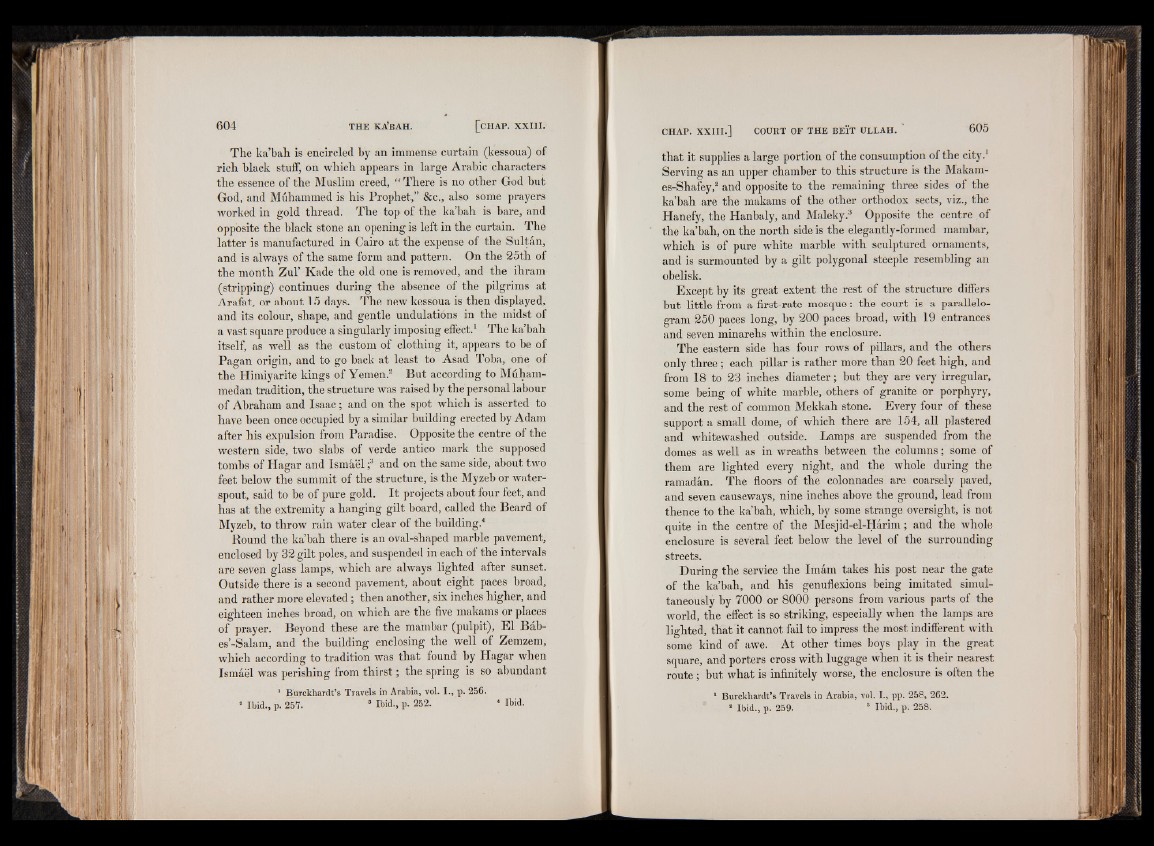
The ka’bah is encircled by an immense curtain (kessoua) of
rich black stuff, on which appears in large Arabic characters
the essence of the Muslim creed, “ There is no other God but
God, and Muhammed is his Prophet,” &c., also some prayers
worked in gold thread. The top of the ka’bah is bare, and
opposite the black stone an opening is left in the curtain. The
latter is manufactured in Cairo at the expense of the Sultan,
and is always of the same form and pattern. On the 25th of
the month Zul’ Kade the old one is removed, and the ihram
(stripping) continues during the absence of the pilgrims at
Arafat, or about 15 days. The new kessoua is then displayed,
and its colour, shape, and gentle undulations in the midst of
a vast square produce a singularly imposing effect.1 The ka’bah
itself, as well as the custom of clothing it, appears to be of
Pagan origin, and to go back at least to Asad Toba, one of
the Himiyarite kings of Yemen.2 But according to Muham-
medan tradition, the structure was raised by the personal labour
of Abraham and Isaac; and on the spot which is asserted to
have been once occupied by a similar building erected by Adam
after his expulsion from Paradise. Opposite the centre of the
western side, two slabs of verde antico mark the supposed
tombs of Hagar and Ismael f and on the same side, about two
feet below the summit of the structure, is the Myzeb or waterspout,
said to be of pure gold. It projects about four feet, and
has at the extremity a hanging gilt board, called the Beard of
Myzeb, to throw rain water clear of the building.4
Round the ka’bah there is an oval-shaped marble pavement,
enclosed by 32 gilt poles, and suspended in each of the intervals
are seven glass lamps, which are always lighted after sunset.
Outside there is a second pavement, about eight paces broad,
and rather more elevated; then another, six inches higher, and
eighteen inches broad, on which are the five makams or places
of prayer. Beyond these are the mambar (pulpit), El Bab-
es’-Salam, and the building enclosing the well of Zemzem,
which according to tradition was that found by Hagar when
Ismael was perishing from thirst; the spring is so abundant
that it supplies a large portion of the consumption of the city.1
Serving as an upper chamber to this structure is the Makam-
es-Shafey,2 and opposite to the remaining three sides of the
ka’bah are the makams of the other orthodox sects, viz., the
Hanefy, the Hanbaly, and Maleky.8 Opposite the centre of
the ka’bah, on the north side is the elegantly-formed mambar,
which is of pure white marble with sculptured ornaments,
and is surmounted by a gilt polygonal steeple resembling an
obelisk.
Except by its great extent the rest of the structure differs
but little from a first-rate mosque: the court is a parallelogram
250 paces long, by 200 paces broad, with 19 entrances
and seven minarehs within the enclosure.
The eastern side has four rows of pillars, and the others
only three; each pillar is rather more than 20 feet high, and
from 18 to 23 inches diameter; but they are very irregular,
some being of white marble, others of granite or porphyry,
and the rest of common Mekkah stone. Every four of these
support a small dome, of which there are 154, all plastered
and whitewashed outside. Lamps are suspended from the
domes as well as in wreaths between the columns; some of
them are lighted every night, and the whole during the
ramadan. The floors of the colonnades are coarsely paved,
and seven causeways, nine inches above the ground, lead from
thence to the ka’bah, which, by some strange oversight, is not
quite in the centre of the Mesjid-el-Harim; and the whole
enclosure is several feet below the level of the surrounding
streets.
During the service the Imam takes his post near the gate
of the ka’bah, and his genuflexions being imitated simultaneously
by 7000 or 8000 persons from various parts of the
world, the effect is so striking, especially when the lamps are
lighted, that it cannot fail to impress the most indifferent with
some kind of awe. At other times boys play in the great
square, and porters cross with luggage when it is their nearest
route; but what is infinitely worse, the enclosure is often the